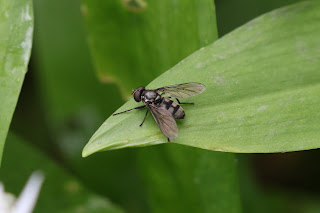Wednesday 11th May 2022, Dolgoch Quarry
Dolgoch Quarry is a disused limestone quarry that is now mainly woodland but the main quarries are relatively clear allowing wild flowers to flourish. The quarries contain a couple of pools which provide a home for aquatic wildlife.
After my many moans about the weather that has greeted us on our outings this year I was resolved not to mention it again…
But!
Heavy rain greeted us as we assembled in the lay-by close to the site.
Undeterred we set off.
To be fair the main path up to the quarries is not very inspiring but some relief is provided when you chance upon a clearing which, considering the conditions, we tried to make the most of.
A couple of beetles were found in this area:
A soldier beetle, Rhagonycha lignosa;
And a rather nicely patterned leaf beetle, Cryptocephalus bipunctatus.
 |
| Photograph: David Williams |
(This photograph was not taken when it was first found but later in the day when the pair were discovered.)
To alleviate us of the despair of treading the main path we had a couple of site experts who took us a different way to the main quarries. It was still through the woods but far more interesting and undulating.
On the way we passed carpets of Ramsons, most of which was in flower.
As we emerged from the woods we found ourselves on top of the hill between the two quarries.
And the rain had eased considerably to what the forecasters might refer to as a light shower.
There were two ways to get down to the quarry floor - tthe quick way, down some steps, or the slow way down a more gently sloping path.
As the steps were muddy and quite steep we deferred from taking the quick way, which may have led to an even quicker descent, and made our way sedately down the slope and into the largest of the main quarries.
The rain had now reduced to the occasional drip.
We had lunch.
And then …
A break in the clouds was spotted …
Quickly followed by the clouds vanishing altogether,
The sun brought about a flurry of activity…
From the gathered throng as they stripped off their outer layers and spread them out to dry …
And from the creatures that inhabited the quarry as they emerged from their shelters to make the most of the warm sunshine.
As the light was now excellent the opportunity was taken to take some aerial photographs:
Of the quarries;
 |
| Photograph: Bob Kemp |
And a selfie.
 |
| Photograph: Bob Kemp |
We were now kept busy as all sorts of interesting insects were found.
Among the first to be spotted were Grizzled skippers.
 |
| Photograph: Bob Kemp |
These were joined by Dingy skippers (in the background at the top of this photograph).
 |
| Photograph: John Martin |
A tiny moth was spotted resting on a rock, Elachista gleichenella.
 |
| Photograph: Bob Kemp |
A soldier fly Odontomyia tigrina, known to some as the Black Colonel, goodness knows why.
 |
| Photograph: John Martin |
And this elongate beetle, Oedemera femoralis, which is a close relative of the far more well-known and common Swollen-thighed beetle.
 |
| Photograph: David Williams |
A pool stands in the corner of this quarry.
A Large red damsel fly and a 4-spotted chaser were observed flying and resting, having emerged recently, presumably, from this pool. On a sapling along its edge we found two male Odynerus spinipes, one of which was photographed.
 |
| Photograph: David Williams |
This has acquired the common name Spiny mason wasp. The mason wasp part refers to its nesting. It excavates its nest in vertical banks of hard earth and uses the waste material to build a chimney over the entrance.
Climbing up some steps to a plateau and then making your way to the to the top of the quarry you get a good view of the area we were in.
 |
| Photograph: David Williams |
Was this an alternative way out to a path that may lead back to where we started?
Sadly, no. It led to a field.
The cloud was building up and the rain threatening to return. We decided to make our way back. But before we left these spiny sawfly larvae were spotted grazing on an oak leaf. They have been identifies as Periclista lineolata.
 |
| Photograph: David Williams |
The rain did return!
We departed along the main track. This involved doing a limbo dance under a tree trunk that had fallen across the path at about chest height and then weaving our way across the upper branches of another fallen tree.
By the time we reached the clearing the rain had stopped and the sun was shining again.
Remember that I said there were carpets of Ramsons. And where there is this plant and the sun, you may chance upon the distinctive hoverfly Portevinia maculata, that is never found far away from the plant.
 |
| Photograph: John Martin |
Keep an eye out for it when you come across Ramsons in the sun.
Another beetle was observed, Malachius bipustulatus.
After the rather wet start. when we were the about the only things to be out in the rain, it had turned into a really good day with some interesting invertebrates to observe.
To round off this account we have the Wednesday Weevil of the Week which is Hypera plantaginis. The one we found was not photographed but here is one that was last year.
 |
| Photograph: Emm Cane-Honeysett |
My thanks to Shropshire Wildlife Trust for permission to do what we enjoy doing and, as always, to the photographers for allowing me to include their images.


.JPG)






























No comments:
Post a Comment
Please feel free to comment on this post...